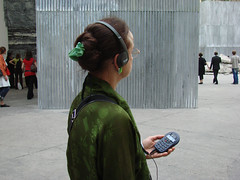Today’s blog post was inspired by a trip to Down House in Kent, where Charles Darwin spent the latter years of his life with his wife and family, and where he wrote, amongst many other works, On the Origin of Species by Means of Natural Selection.
It was a fascinating day out, and I thoroughly recommend it, but what prompted me to write was their wonderful new multimedia guides. On arrival we (my mum, my fiancée and myself) were each handed a fairly ruggedly built little PDA with headphones attached. Having arrived too early to see the house (the gardens open at 10am, but the house doesn’t open until 11) we set off into the garden, shown around by our multimedia guides.
Audio guides to exhibitions and historical sites aren’t particularly new, and I have vague recollections of having been using them for some years, but it seems that the people responsible for setting these things up are getting a lot more creative. Additionally, the technology is becoming better and cheaper: not long ago handing every visitor a PDA would have been out of the question, but English Heritage have found funding from somewhere and I think it’s worth every penny.
Although the guide is set up to take you round in a specified order by default, you can also bring up a map, labelled with all the locations that have audio content so that you can skip bits out or make up your own tour of the grounds. After the main narration for each location, given by Andrew Marr in the garden and Sir David Attenborough in the house, there is a menu of other short bits of relevant information, taken from interviews with various experts. We were each able to customise our tour and include only the information we were interested in: very useful when we moved onto the house and time was starting to run a bit short. There is also a small interactive game for each section, which should help to keep the kids entertained.
It’s very freeing having a well-written audio guide to an English Heritage property. The best part is that you can look around at whatever is being described without having to constantly shift attention between it and an information plaque. Also having the full-colour screen on the device meant that photos and videos could be shown, which added an extra dimension to the tour.
There were a few minor shortcomings with the guides. The headphone cables were very long and got caught up occasionally. The visual aspects of the guide occasionally felt like they were needlessly distracting from what I was looking at. Also, having an audio guide did dampen down conversation within our little group, but reading text on displays often has the same effect so there probably wasn’t much lost. All in all though, it was a very well designed package.
The whole thing put me in mind of another, very different but equally enjoyable, audio tour. This one was at the Commandery in Worcester. The Commandery is a very old building indeed and has been repurposed many times through its history. It’s recently been refurbished, and it’s been done in quite a wonderful way.
The whole place has been fully redecorated but left almost empty. On arrival you’re given an audio guide and you then choose one of the periods of history (I think there were five). You then take a tour of the whole building from the perspective of that period. Because the decoration is so sparse, it’s necessary to imagine how it would have been in days gone by, and the narration, dramatisation and atmospheric sounds on the audio guide really bring the period to life. Because we chose different periods for our tours, we were able to compare notes and it turns out that there are some nice links between the different narrations.
I really enjoyed both of these audio tours. The Commandery, in particular, I would love to revisit and spend the whole day doing the tours for each of the different periods of history. But the experience has really reminded me that putting control of learning into the learner’s hands can sometimes quite literally mean just that, and that it can work very well indeed. I felt that I was able to really get a handle on Darwin’s life and work in a way that wouldn’t have been possible by just walking round the garden or reading a display: the experience made use of all of my senses.
What’s your take on audio/multimedia guides? When do they work and when do they detract from the experience? Leave me a comment below.

